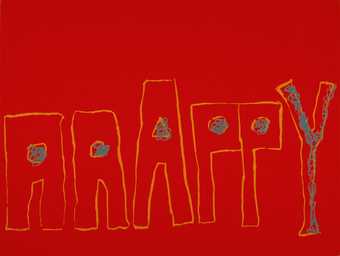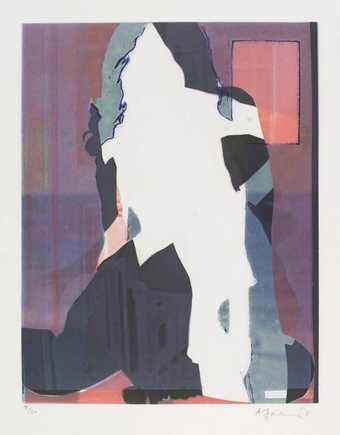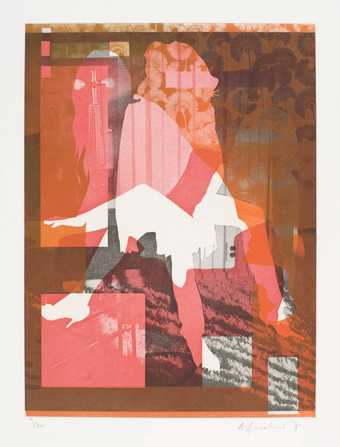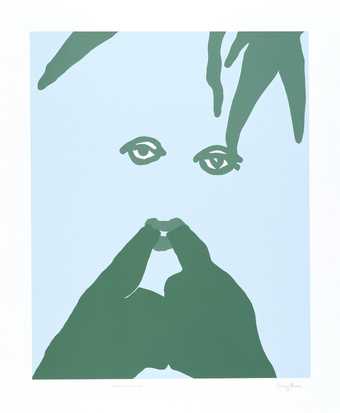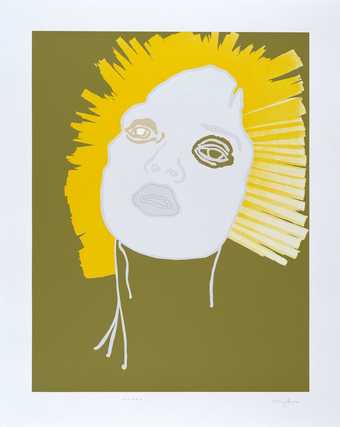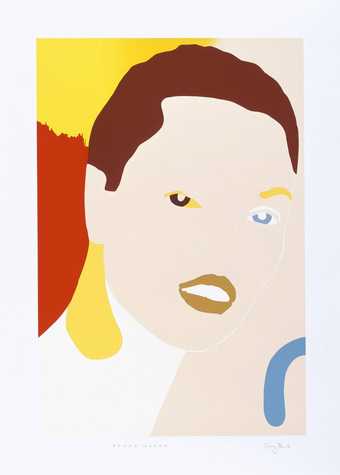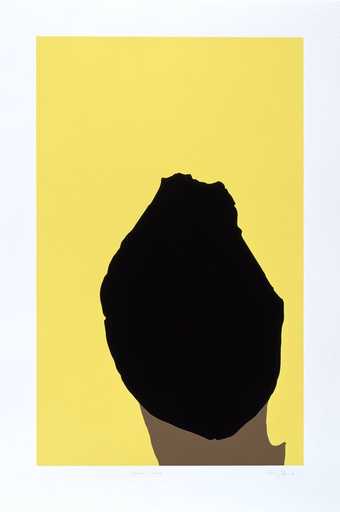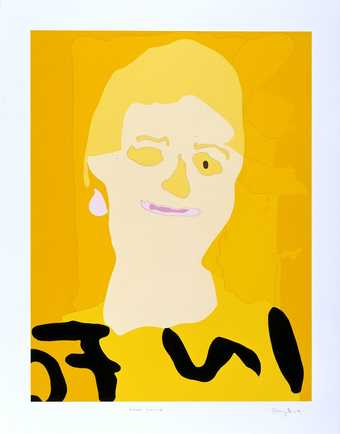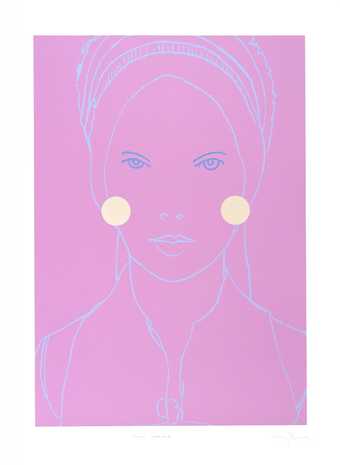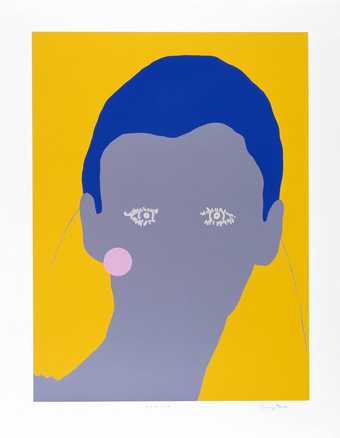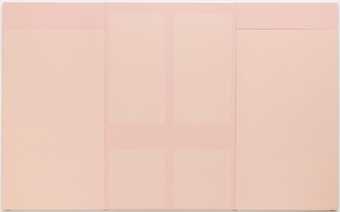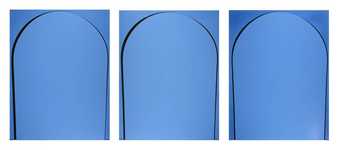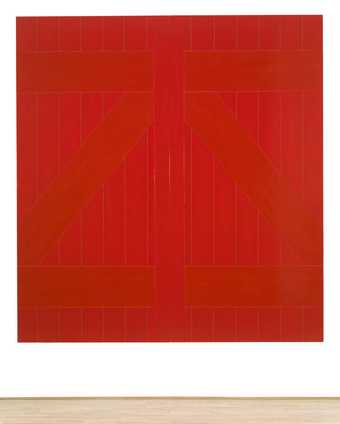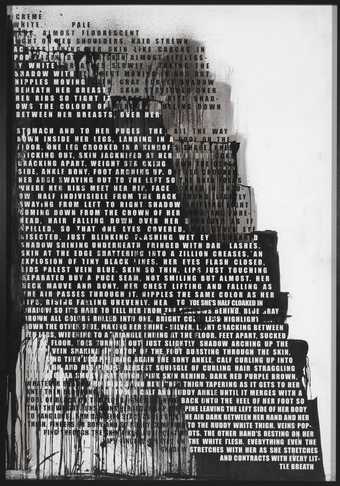
Not on display
- Artist
- Gary Hume born 1962
- Medium
- Household paint on aluminium panel
- Dimensions
- Support: 3050 × 2440 × 21 mm
- Collection
- Tate
- Acquisition
- Presented by the Friends of the Tate Gallery 2000
- Reference
- T07618
Summary
This is one of a series of several Water Paintings Hume made in 1999. The Water Paintings are silhouettes of women outlined against a monochrome background. The women's standing bodies have been drawn in another colour by painting over the background. Tate's Water Painting is green with white outlines. The drawn figures are large, their heads and torsos filling the canvas, and are layered over one another. They appear as a series of overlapping lines, resulting in fragments of faces, shoulders, breasts, arms and hands not clearly belonging to any one distinct entity. The women range in size, creating a sense of perspective and movement, which could be read as a series of freeze-frame images of a body moving towards the viewer. Varying hairstyles are the only indication of difference between women whose stylised bodies seem identical, the representation of an idealised form. Hume usually traces his images from photographs (found in magazines and books or taken himself) onto a sheet of acetate and projects the outline onto his hard painting surface. The Water Paintings were made from photographs, followed by drawings, of Hume's wife Georgie and a friend, Zoe. He then fills the outlined areas with paint in sections of monotone colour. He uses household gloss paint for its reflective qualities and has commented that 'the high-gloss finish
starts to have a life of its own because it reflects the environment the paintings are shown in
they make you think about light and about where the paintings begin and end' (quoted in 'Brilliant', p.45).
Hume is one of the group of young British artists whose careers were launched by the seminal group show Freeze, organised and curated by artist Damien Hirst (born 1965) in London's Docklands in 1988. A characteristic of the work of artists in this exhibition was the appropriation of everyday objects and subjects. Hume's contribution was three large canvases covered in mint-white household gloss paint titled Mint Green Doors I-III 1988 (Saatchi Collection, London). Soon after this he abandoned canvas and began painting on MDF board and Formica panels, creating obsessively smooth surfaces and developing the theme of doors. These mainly monochrome and two-colour paintings are literal representations of double swing doors, often with round porthole-style windows, made using the type of paint which is generally used to coat the original doors. Such individual titles as Incubus 1991 (Tate T07184) confer wider associations. In the early to mid 1990s Hume painted such iconic subjects as the Christian Madonna 1993 (private collection, London) as well as such everyday objects as flowers, birds, children's toys and feet or hands. He also made portraits of artists and celebrities, from which he later derived his portfolio of prints, Portraits 1998 (Tate P78195-204). These paintings are decorative, simplified and abstracted representations. Their vivid colours and cartoon lines are reminiscent of the late prints of French artist Henri Matisse (1869-1954).
Hume has likened his shiny, skin-like painted surfaces to makeup painted over flesh ('Brilliant', p.45). This suggests an interest in the difference between the surface and what it covers or represents. The Water Paintings represent the icon 'woman' as a multiple and vertically moving figure, no longer the still and horizontally positioned object traditional to painting. The progressive movement of the women's faces and upper bodies towards the viewer make them active rather than passive subjects, a series of watery beings in rippling, fluid lines and shiny surfaces. With their reflective sheen, the Water Paintings provide a mirrored surface in which the viewer may see him or herself within the outlines of large female bodies. Historically associated with the female and the unconscious, water also evokes the elemental and spiritual. Hume has stated, 'all my paintings are religious' (quoted in Lindsay Baker, 'The Beauty Bomber', Guardian Weekend, 2 May 1998, p.43).
Further reading:
'Brilliant' New Art from London, exhibition catalogue, Walker Arts Centre, Minneapolis 1995, pp.42-5
Gary Hume, exhibition catalogue, British Pavilion, XLVIII Venice Biennale, British Council 1999, reproduced (colour) p.31 and (detail) front and back covers
Gary Hume, exhibition catalogue, Fundació "la Caixa", Barcelona 2000, pp.90-5 and 124
Elizabeth Manchester
May 2002
Does this text contain inaccurate information or language that you feel we should improve or change? We would like to hear from you.
Display caption
Gallery label, September 2004
Does this text contain inaccurate information or language that you feel we should improve or change? We would like to hear from you.
Explore
- abstraction(8,615)
-
- from recognisable sources(3,634)
-
- figure(2,270)
- formal qualities(12,454)
-
- colour(836)
- female(1,681)
You might like
-
Gary Hume [no title]
1994 -
Angus Fairhurst Unprinted I
2005 -
Angus Fairhurst Unprinted II
2006 -
Gary Hume Whistler
1998 -
Gary Hume Angel
1998 -
Gary Hume Young Woman
1998 -
Gary Hume Yellow Hair
1998 -
Gary Hume Funny Girl
1998 -
Gary Hume Poor Thing
1998 -
Gary Hume Lady Parker
1998 -
Gary Hume Cerith
1998 -
Gary Hume Incubus
1991 -
Ian Davenport Poured Painting: Blue, Black, Blue
1999 -
Gary Hume Red Barn Door
2008 -
Fiona Banner Spilt Nude
2007

